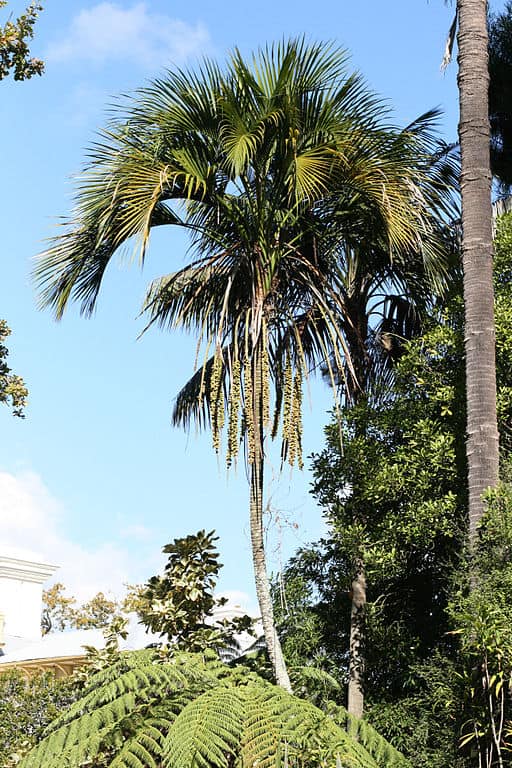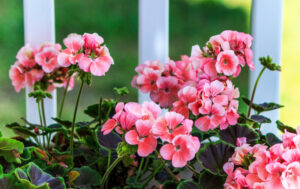There are lots of Indoor Palm Varieties that you can grow in your home or in an apartment. All these types of indoor palm plants remain small enough to grow in a medium-sized pot. And these palm plants require minimal care, so you’ll easily be able to keep them alive even if you don’t have a green thumb.
Continue reading this article to learn more about each type of indoor palm, and you can even buy each palm tree on this list if you’re ready to bring a touch of the tropics into your home.
Indoor Palm Varieties
Chinese Fan Palm – Livistona chinensis
The Chinese Fan Palm (Buy Online) as its name suggests is native to China and Southeast Asia. The Chinese fan palm can grow to be quite large when it’s grown outdoors, but you can keep it relatively small when it’s grown in a pot indoors.
The Chinese Fan palm has large fan-shaped leaves that grow on stems and the fronds have sharp protective thorns. As the plant grows it sheds its older fronds, and the base of each frond serves as a protective layer around the trunk of the palm.
The Chinese fan palm is very hardy and it only requires minimal care. It can even tolerate colder temperatures than most palms, and it grows well in low light, which makes it a perfect palm to grow indoors.
Areca Palm – Dypsis lutescens
The Areca Palm (Buy Online) is also known as the golden cane palm or the butterfly palm. It originates from Madagascar and parts of Southern India. This palm has large feathery fronds and it produces multiple thin trunks that are reminiscent of bamboo stalks.
The Areca Palm will grow to a height of about 6 to 7 feet, but it will stay compact if you grow it in a small pot. The Areca Palm prefers to be grown near a window in bright indirect sunlight, but it can be grown in low light conditions as well.
Majestic Palm – Ravenea rivularis
The Majesty Palm (Buy Online) is also known as the Majestic palm. They are native to the warm tropical jungles of Madagascar. The Majesty Palms starts their life in the undergrowth of the jungle, so they are very shade tolerant. However, they are a little demanding when it comes to warmth, moisture, and humidity.
The Majestic Palm is a very slow grower, which makes them an excellent indoor houseplant since it can take them a while to get too large for your home. However, in the wild they can grow to a height of 80 to 100 feet with fronds that can grow to be 8 feet long. So, it might eventually outgrow your living space especially if you don’t have much space to spare or if you live in an apartment.
Ponytail Palm – Beaucarnea recurvata
The Ponytail Palm (Buy Online) hails from the Eastern portion of Mexico, and they are also known as the bottle palm and the elephant foot tree. The Ponytail Palm is not a true palm even though it has palm in its name. Instead, it’s more closely related to asparagus since it’s a member of the Asparagaceae family of flowering plants.
When grown indoors the Ponytail palm can reach a height of about 3 feet tall, but when they are grown outdoors they can grow to be over 20 feet tall. Ponytail palms also make great Bonsai plants since they can tolerate being root-bound, which means they can be trained to remain small, and they don’t need to be transferred to a new pot that often.
The real standout feature of the ponytail palm is its short bulbous trunk. They use their large trunk to store water since they come from an area where they commonly experience prolonged droughts. Due to this unique adaptation, the Ponytail Palm is great for people who always forget to water their plants.
Sago Palm – Cycas revoluta
The Sago Palm (Buy Online) hails from southern Japan, but they are not true palms. Instead, sago palms are actually Cycads, which are an even older plant species that date back 280 million years to the early Permian. Sago palms have stiff bristle-like dark green fronds that emerge from a stout hairy trunk.
The sago palm has a very small trunk when it’s young, and in some cases, the trunk won’t even rise above the soil line. but over time the plant can reach a height of 20 feet tall when grown outdoors.
You don’t have to worry about the sago palm getting too large indoors since it’s a very slow grower, and it can take a century to reach its full height. However, it’s important to know that the sago palm can be toxic when ingested, so its’ not the best indoor palm if you have pets that like to nibble on your houseplants.
Yucca Palm – Yucca elephantipes
The Yucca Palm (Buy Online) is also known as the yucca cane or the stick yucca. It originates from Southern Mexico and Central America. The Yucca palm fits in well with most houseplants, and it even looks a little like a dragon tree Dracaena. It also does well indoors since it stays small, and you can even grow it in partial shade, and it’s extremely drought tolerant.
Fishtail Palm – Caryota mitis
The Fishtail Palm (Buy Online) comes from the warm tropical jungles of Southeast Asia. It gets its name from its broad leaves that have a shape reminiscent of a fish’s tail. These palms are often sold as a clump of small plants that produce lots of stems that create a thick canopy of fronds.
The Fishtail Palm will grow fast and they can reach a height of about 10 feet when grown indoors, so they are better suited to homes with high ceilings. They also need bright sunlight to thrive, and they prefer to grow in a high humidity environment, but regular misting will help them thrive.
Cascade Palm – Chamaedorea cataractarum
The Cascade Palm (Buy Online) is also known as the cat palm or the Mexican hat palm. This palm originally hails from Southern Mexico and Central America. This palm produces a thick wall of lush delicate green fronds that create a cascading effect as they grow.
The Cascade Palm will reach a maximum height of about 6 feet when it’s grown indoors, and their cascading fronds need lots of space, so you’ll need to grow it in a large room.
Cascade palms need lots of water since they naturally grow near streams in waterlogged soil. Luckily, they don’t need a lot of sunlight since they are an understory palm that thrives in humid low light environments.
Bamboo Palm – Chamaedorea seifrizii
The Bamboo Palm (Buy Online) originates from the Central American region in and around Mexico. They are called the bamboo palm since they have long bamboo-like stalks. The Bamboo Palm tends to grow in clusters that produce long semi-broadleaf fronds.
The Bamboo Palm makes a great houseplant since they grow very slowly, and they are tolerant of low light conditions. They also don’t need much humidity in the air to thrive, so they do well in dry climates, and in colder areas in the winter months. They can grow to a height of 4 to 13 feet tall, and they can spread out considerably and reach 2 to 5 feet wide.
European Fan Palm – Chamaerops humilis
The European Fan Palm (Buy Online) is from Europe as its name implies, which makes them a unique palm species since most palms come from tropical climates. The European Fan Palm primarily grows in the western parts of the Mediterranean.
Since the European Fan Palm grows in continental Europe it’s one of the most cold-hardy palms, and it can tolerate temperatures of 5 degrees Fahrenheit for a limited time. The European Fan Palm will grow to a maximum height of 5 to 10 feet, but they stay smaller when they are grown indoors. They also have very broad fan-like fronds that can reach 15 to 25 inches wide.
Kentia Palm – Howea forsteriana
The Kentia Palm (Buy Online) is native to Australia, and it’s also known as the Thatch Palm and the Paradise Palm. It’s a very popular indoor palm since it’s hardy and easy to care for, and it’s also a very beautiful palm. It can even grow in low light conditions, and it can handle lower temperatures and it doesn’t need high humidity to thrive. It’s also a slow grower, and it fills out and area nicely since it tends to grow in clumps with long arcing fronds.
Pygmy Date Palm – Phoenix roebelenii
The Pygmy Date Palm (Buy Online) comes from the warm tropical jungles of Southeast Asia. They can grow to a maximum height of 8 to 10 feet and they do best when grown in bright indirect light.
The Pygmy Date Palm needs to be grown in an area with high humidity, but you can also mist them daily when the air in your house gets dry. The Pygmy Date Palm doesn’t look too menacing but they do have sharp spines on their fronds, so it’s best to keep them out of the reach of pets and children.
Canary Island Date Palm – Phoenix canariensis
The Canary Island Date Palm (Buy Online) is closely related to the pygmy date palm, but Phoenix canariensis is only found naturally in the Canary Islands. When Canary Island Date Palms are grown outdoors they can reach a height of 65 feet tall, and their fronds can stretch out to a width of 40 feet.
Luckily, you don’t have to worry about the Canary Island Date Palm growing that large indoors since they grow very slowly, and they can take over a decade to reach 10 feet tall. They have a similar growth habit to the sago palm with straight narrow stiff fronds. They also prefer high humidity and light, so they’ll do well with regular misting in an area with lots of indirect sunlight.
Lady Palm – Rhapis excelsa
The Lady Palm (Buy Online) also goes by the name Rhapis palm, and they are endemic to the warm tropical regions in Southeast Asia. They have broad shiny leaf-like fronds that fill out the whole plant. Due to their bushy nature, they will need to be pruned to make them grow more like a regular palm.
The Lady Palm will grow to a height of about 2 to 6.5 feet tall, and they are slow growers, so they won’t reach that height for a long time. They also like to grow in shade, so they should be kept out of direct sunlight, and they will even do well indoors under bright artificial light.
Ruffled Fan Palm – Licuala grandis
The Ruffled Fan Palm (Buy Online) is also known as the Vanuatu Fan Palm and the Palas Fan Palm. This showy palm has large glossy leaves that look like a traditional Japanese fan. They make a beautiful houseplant, and they are very slow growers, and they also require very little maintenance to thrive. They remain short when grown indoors, and they usually max out at 4 to 6 feet tall. They do like humid conditions, so it’s a good idea to mist them periodically to keep their fronds in good condition.
Sentry Palm – Howea belmoreana

The Sentry Palm (Buy Online) is native to Australia and it shares a lot of features with the Kentia palm. It has long flowing feather-like fronds that curl over on themselves, and they can grow to be quite large. When they are grown indoors they can easily reach a height of 8 feet, but they can be cut back and new fronds will emerge from the Sentry Palms short trunk.
Christmas Palm – Adonidia merrillii
The Christmas Palm (Buy Online) is a stately palm that is native to the Philippines. This palm also goes by the name Manila Palm, and it makes an excellent outdoor or indoor palm. The Christmas palm has lots of ornamental appeal since it will produce bright red fruits during the winter. It tolerates shade well but is a bit of a water hog so you’ll need to water it more than most palms.
Parlor Palm – Chamaedorea elegans
The Parlor Palm (Buy Online) is one of the most popular indoor palms, and they are very easy to grow even if you don’t have a green thumb. They originally came from central and South America, and they also go by the name Neanthe Bella Palm. When the Parlor palm is grown indoors it will usually top out at a height of around 4 to 6 feet tall.
The Parlor Palm grows in clusters with lots of small plants bunched together, which give it the appearance of being a single large palm. They will also produce small flowers in ideal conditions.
The Parlor Palm is a slow grower, and they do well in both low light and indirect sunlight. They aren’t picky about the temperature in your home, but they do need above average humidity to thrive, but you can mist them regularly and they will do just fine.






















